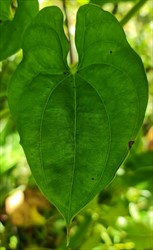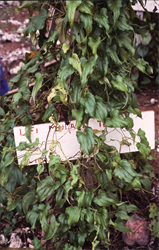Yam mild mosaic
Pacific Pests, Pathogens, Weeds & Pesticides - Online edition
Pacific Pests, Pathogens, Weeds & Pesticides
Yam mild mosaic virus disease (530)
Yam mild mosaic virus; previously known as Dioscora alata virus, Yam virus 1. The virus belongs to the genus Potyvirus. The particles are flexuous rods. It is likely that there are two related groups of YMMV, one from Africa and the other from Southeast Asia, sharing a common ancestor. The abbreviation of the virus is YMMV.
Asia, Africa (West Africa), South America (Colombia), the Caribbean, Oceania. YMMV is recorded from Fiji, New Caledonia, Papua New Guinea, Solomon Islands, and Vanuatu. It is likely to be present in all countries where Dioscorea alata is grown.
Dioscorea species. Dioscorea alata (called the greater yam, water yam); Dioscorea esculenta (Chinese yam); Dioscorea dumetorum (bitter yam); Dioscorea cayenensis-rotundata (Guinea yam), and Dioscorea trifida (Indian yam or cush-cush yam).
Yam mild mosaic is the second most important virus disease of yams after that caused by Yam mosaic virus (see Fact Sheet no. 526). Symptoms on leaves vary: mild yellowing, yellow and green spots, mottles and mosaics (Photos 1-3), and occasionally severe leaf distortions and stunting (Photo 4).
Spread over short distances through sap from an infected to a healthy plants is possible when leaves are blown together by wind. However, it is likely that the more common method of spread is by aphids (e.g., Aphis gossypii and Aphis craccivora), and through vegetative propagation.
Aphids continuously probe plants with their mouth parts as they move through the crop. In so doing, the virus is transmitted in a non-persistent way. This means only a short feed is needed (a minute or two) before the aphid can infect a healthy plants, and soon the ability to infect is lost; there is no multiplication of the virus inside the aphid.
Spread of yam mild mosaic by aphids is important, but so too is spread by vegetative propagation. The virus passes from the planting set to the developing plant and then to its tubers. Farmers may inadvertently help in the process by eating or selling the largest tubers and saving the smallest as ‘seed’ for next season’s crop. Unfortunately, the smallest may have not grown well because of virus infection. Additionally, social exchanges may also play a part in the spread of yam mild mosaic.
The economic impact of yam mild mosaic is not known. Loss of yield is likely where severe leaf distortion and stunting occurs, but tests to prove it are affected by: (i) rapid reinfection by aphids if tests are done in the field; and (ii) reinfections are likely to include other (insect-borne) viruses. Impact studies need to take into account not only yield but also decreased tuber size and quality, which may impact seed availability for the next crop and negativiely affect potential sales, respectively.
Look for spots, mottles, mosaics and stunted plants, but note that symptoms are similar to those caused by YMV. YMMV is mechanically transmissable to Nicotiana clevelandii and Chenopodium species is possible, as well as aphid transmission to Vigna unguiculata. It is not mechanically transferable to Nicotiana benthamiana, whereas YMV is. The two viruses can also be differentiated using ELISA and PCR, and antisera are commercially available for both. LAMP assays have been developed for YMMV (and YMV).
BIOSECURITY
Multiple infections with different species or strains of virus are relatively common in yam. Therefore, it is important not to move viruses between different regions. Unofficial introductions of yams provide the greatest risk of spreading viruses, as they do with all vegetatively propagated crops. Transfers should be made as sterile, pathogen-tested plants growing in vitro, following the FAO/IBPGR (1989) Technical Guidelines for the Safe Movement of Yam Germplasm.
Major programs for the production of yams of several species free from viruses exist at the International Institute of Tropical Agriculture (IITA), Ibadan, Nigeria; the Centre for Pacific Crops and Trees (CePaCT), SPC, Fiji; and the Biological Resources Center for Tropical Plants (BRC-TP), Guadeloupe.
CULTURAL CONTROL
Little research has been done on the control of this disease. However, it is speculated that weed management, the use of 'clean' - virus-free -seed and control of aphid vectors would be beneficial if applied in combination.
Before planting:
-
Choose sets carefully. Yams for propagation should be from the healthiest plants, invariably those that produced the largest tubers. ‘Seed’ yam producers should always choose tubers this way, perhaps using the mini-sett technology to accelerate multiplication:. https://www.ctahr.hawaii.edu/adap/Publications/Ireta_pubs/rapidyams.pdf.
-
Note, best practtice is not to plant next to plots with the disease or downwind from them, but such is the ease of spread of Yam mild mosaic virus, and the fact that yams are vegetatively propagated, it is likely that plants are infected already.
During growth:
-
Rogue any plants that show early severe symptoms. Even though all plants are likely to be infected, some with early symptoms should be removed to prevent their use as setts the next season. It is likely that adjacent plants will take advantage of extra space, and yield loss from rogueing will be minimal.
-
Weed. Many species are hosts of aphids. Aphid populations build up on weeds and then migrate to yams, probing plants as they go for their suitability as new hosts. Although the aphids may not remain on the yams, they can still spread the virus as they travel through the crop.
After harvest:
-
Collect and destroy plant debris. This includes undersized tubers, which should be eaten rather than kept for planting.
RESISTANT VARIETIES
None reported for yam mosaic disease, but IITA has a breeding program to improve yam germplasm conservation and use. In Vanuatu, the breeding program has concentrated on the production of superior lines with anthracnose resistance (see Fact Sheet no. 16).
CHEMICAL CONTROL
This is not appropriate for the management of this disease. Insecticides can kill the aphids that spread YMMV, but that does not necessarily prevent virus infection. This is because the time between the virus attaching to the aphid's mouthparts when it feeds on a diseased plant, and spreading the virus as it feeds on a healthy plant, is short; by the time the insecticide has killed the aphid it has spread the virus.
AUTHOR Grahame Jackson
Information from Kenyon L, et al. (2001) An overview of viruses infecting Dioscorea yams in Sub-Saharan Africa. In: Proceedings of a conference on Plant Virology in Sub Saharan Africa, 4-8 June 2001, Ibadan, Nigeria.(https://www.researchgate.net/publication/216088409_An_overview_of_viruses_infecting_Dioscorea_yams_in_Sub-Saharan_Africa); Brunt AA, et al. (eds) (1989) FAO/IBPGR Technical Guidelines for the Safe Movement of Yam Germplasm. Food and Agriculture Organization of the United Nations, Rome/International Board for Plant Genetic Resources, Rome. (http://ecoport.org/Resources/Refs/IPGRI/yam.pdf); and Naidu RA, Hughes JDA (2003) Methods for the detection of plant virus diseases. In: Proceedings of a conference on Plant Virology in Sub Saharan Africa, 4-8 June 2001, Ibadan, Nigeria, (pp. 233-253). (https://cgspace.cgiar.org/handle/10568/96508); and Luo GF, et al. (2021) A review of viruses infecting yam (Disoscoea spp): implications for safe exchange of Pacific yam germplasm. Viruses 13; and Yam mild mosaic virus (2021) Crop Protection Compendium. CABI. (https://www.cabi.org/cpc/datasheet/19292); and Umber M, et al. (2020) Molecular virus diagnostics and sanitation of yam genetic resources: Implications for safe yam germplasm exchange. Viruses 12: 1101. (https://www.mdpi.com/1999-4915/12/10/1101); and Lopes-Montes A, et al. (2012) Yam breeding at IITA: achievements, challenges, and prospects. Research for development review. (https://biblio1.iita.org/bitstream/handle/20.500.12478/1579/U12ArtLopezmontesYamNothomNodev.pdf?sequence=1&isAllowed=y/).; and from Diouf MB, et al. (2022) Viruses of Yams (Dioscorea spp.): Current Gaps in Knowledge and Future Research Directions to Improve Disease Management. Viruses 14: 1884. (https://doi.org/10.3390/v14091884).
Produced with support from the Australia Centre for International Agricultural Research under project HORT/2016/185: Responding to emerging pest and disease threats to horticulture in the Pacific islands, implemented by the University of Queensland, in association with the Pacific Community.







